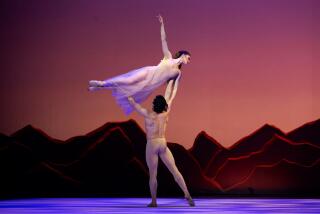TWO COMPANIES RE-CREATE RAMEAU’S BALLET/OPERA : ‘Fabulous’ Music of an 18th-Century Hit
- Share via
Current fashion to the contrary, James Richman does not live and die for “authentic” performances whenever he leads Concert Royal in music of the baroque. As an example, the New York-based conductor cites the collaboration by his 28-member vocal-and-period-instrument ensemble and the New York Baroque Dance Company in Rameau’s “Les Fetes d’Hebe” this weekend.
The point of this new production, he stresses, is not merely to re-create a museum piece: “We want to arrive at an interpretation that will show people how fabulous this music is.
“Authentic? No, this is not an exact reproduction. However, the dancing, the sets, the instruments, the costumes--even the underwear--are as close as possible. If I had $1 million, I’d do it authentic.”
For the 37-year-old musician, maintaining a fragile balance between scholarship and entertainment values remains the key to a successful staging. “The piece will look quite natural to audiences today. It’s going to be alive, but it will also be true to the 18th Century--and that is not a contradiction in terms.”
Though Rameau labeled the 1739 piece a ballet, Richman is more inclined to call it an opera. His reasoning stems not so much from his prejudicial preferences, but from the derivation of the word itself: “The term opera means ‘The Work’ (actually, it is the plural form). And that’s how audiences approached it back then. They understood that this was it, that the best music a composer could offer would be in his operas.
“ ‘Les Fetes d’Hebe’ was a very big hit. For instance, look at Handel’s most popular opera, ‘Rinaldo.’ That received about 50 performances. The Rameau remained in the repertory for 40 years, and was presented 400 times. Then, as now, people wanted a nice song-and-dance show. They didn’t think of this as High Art.”
Richman does admit that tastes have changed a bit. Song-and-dance fans today are less interested in lavishly dressed singers and dancers depicting Greek gods and goddesses frolicking by the Seine.
“Bear in mind,” he cautions, “that in Rameau’s time, you weren’t actually talking about gods--you were talking human beings. The characters represent human personalities. They deal with things people can understand: love disquieted, love fulfilled and, above all, the triumph of art.”
If many of the elements in “Les Fetes d’Hebe” are timeless, why not dispense with the trappings of a bygone era? Surprisingly, Richman does not scoff at such a suggestion. “You can do Rameau in spacesuits. Now, I’m not saying it’s wrong, but there’s so much to be gained by achieving the consciousness of what they were doing back then. You can play the music on modern instruments, but this score really wants the original sound.
“When I go to a museum and see a work of Leonardo, I view it with 20th-Century eyes, and it’s not dead. If I can view the ‘Mona Lisa’ with contemporary eyes, why can’t I experience baroque opera with 20th-Century ears?”
More to Read
The biggest entertainment stories
Get our big stories about Hollywood, film, television, music, arts, culture and more right in your inbox as soon as they publish.
You may occasionally receive promotional content from the Los Angeles Times.










